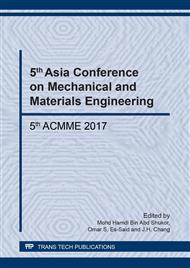p.187
p.193
p.199
p.207
p.213
p.219
p.225
p.231
p.237
Preparation of Copper-Doped Nickel Oxide Thin Films by Sol-Gel Method Using Nickel and Copper Acetate
Abstract:
We have prepared nondoped and Cu-doped NiO thin films by sol-gel method on SiO2 substrate using nickel acetate and copper acetate as precursors. Thin films of NiO were formed by thermal annealing of gel films at 500 - 900°C for 10 h in air. X-ray diffraction (XRD) peaks of NiO have been observed at higher annealing temperature than 500°C, and intensity of the peaks increased with annealing temperature until 800°C. On the other hand, the dependency of XRD signal intensity on annealing temperature becomes less significant by Cu-doping. Nondoped NiO films show high transparency at lower annealing temperatures than 800°C. The result means that the film with high crystalline volume ratio is not consistent with the films with high transparency. Cu-doping decreases the transmittance of the films with low crystalline volume ratio. It is considered that the doped Cu atoms exist in amorphous fraction make the transmittance lower. Conductivity of the films is increased with Cu-doping only in the films annealed at 500 - 700°C. The highest conductivity obtained in the Cu-doped film is around 10-6 W-1cm-1 at 600°C. On the other hand, the Cu-doped films show similar conductivity to nondoped films at high annealing temperature, 800 or 900°C.
Info:
Periodical:
Pages:
213-218
Citation:
Online since:
November 2017
Authors:
Keywords:
Price:
Сopyright:
© 2017 Trans Tech Publications Ltd. All Rights Reserved
Share:
Citation:


